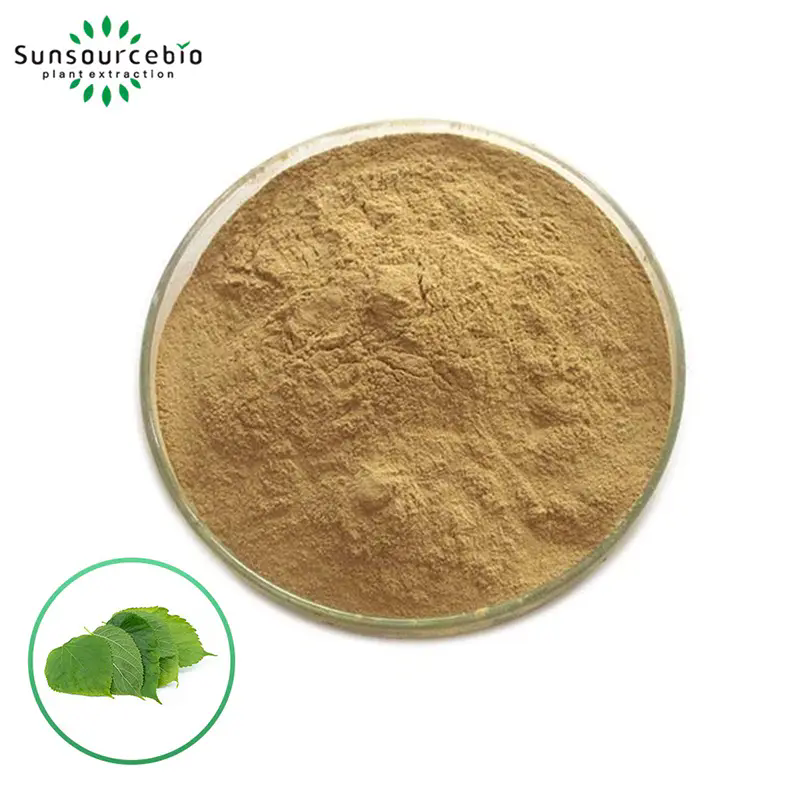What makes Mulberry Leaf Extract a breakthrough for blood sugar, heart health and future wellness trends?
2025-10-21
Mulberry Leaf Extract (derived from the leaves of the plant species Morus alba and related mulberry species) is a powdered or concentrated form of the leaves, rich in bioactive compounds such as flavonoids, phenolics and 1-deoxynojirimycin (DNJ). Historically used in traditional Chinese and Asian herbal medicine, this extract is now gaining traction in modern nutraceuticals and functional-food applications.
Product Specifications
Below is a summary of key product parameters to illustrate professional rigor:
| Parameter | Typical Value / Specification |
|---|---|
| Source plant | Morus alba (white mulberry) and/or other Morus species |
| Active marker compound(s) | DNJ (1-deoxynojirimycin) ≥ 5% (for standardised extract) |
| Typical extraction ratio | e.g., 10:1 or 20:1 leaf to extract (varies by manufacturer) |
| Formulation types | Powder, capsule, tablet, liquid extract |
| Common dosage in study settings | ~250 mg–1 g extract three times daily (varies) |
| Claimed functional benefits | Blood sugar regulation; cholesterol & lipid support; anti-inflammatory and antioxidant activity |
| Safety considerations | Possible gastrointestinal effects; interaction with anti-diabetic drugs |
Why is Mulberry Leaf Extract gaining attention?
Mechanisms of action
The extract’s effectiveness in health applications can be attributed to several biochemical pathways and bioactive compounds:
-
Carbohydrate-absorption inhibition: The DNJ in mulberry leaf extract acts as an alpha-glucosidase inhibitor in the intestine, limiting the breakdown of complex carbohydrates into glucose, thereby reducing post-meal blood glucose spikes. For example, a clinical trial found that consumption of the extract resulted in a 42 % lower peak in post-prandial glucose compared to placebo.
-
Antioxidant and anti-inflammatory activity: The leaves contain flavonoids and phenolic compounds that suppress oxidative stress biomarkers and pro-inflammatory cytokines (such as IL-1β, IL-6) in vitro and in vivo.
-
Cardiometabolic modulation: Research indicates potential for cholesterol-lowering, blood pressure reduction and vascular function improvement. For example, an extract inhibited angiotensin-converting enzyme (ACE) activity and exhibited calcium-channel-blocking effects in animal models, contributing to improved vascular reactivity.
Functional benefits & health-claim potential
Given its mechanisms, Mulberry Leaf Extract holds promise across several health domains:
-
Blood sugar support: Multiple human studies show reduction in post-meal glucose and insulin levels when the extract is taken before or with carbohydrate-rich meals.
-
Heart and vascular health: Early evidence suggests improvements in cholesterol profiles, triglyceride reduction and endothelial health support.
-
Weight management and metabolic health: Some animal studies show inhibition of adipogenesis (fat-cell formation) and enhancement of fat-burning pathways.
-
General wellness/anti-aging: By mitigating oxidative stress and inflammation, the extract can be positioned in functional foods or beverages targeting “wellness lifestyle” consumers.
-
Emerging uses: There is growing interest in immune-health modulation and gut-barrier support via mulberry leaf extract.
Market trends and formulation advantages
From an ingredient manufacturer or buyer perspective, Mulberry Leaf Extract checks a number of boxes:
-
Plant-based, familiar to consumers with herbal-medicine heritage
-
Standardisable with marker compounds (such as DNJ)
-
Synergistic applications in dietary supplements, functional beverages, teas and food fortification
-
Rising consumer demand for natural glycaemic- and cardiometabolic-health solutions
These factors together create a favourable environment for this ingredient’s growth in global functional-food and nutraceutical markets.
How to use Mulberry Leaf Extract — applications, dosing, opportunities & caution
Formulation and usage guidelines
For ingredient developers and formulators interested in integrating Mulberry Leaf Extract into products, the following are key considerations:
-
Dosage: Human trial data suggest effective doses around 250 mg to 1 g of extract (standardised for DNJ) taken with meals, particularly carbohydrate-rich meals, to blunt glucose spikes.
-
Delivery formats: Fast-dissolving tablets, chewables, powders loaded in drink mixes or ready-to-drink formats enhance bioavailability and faster onset of action. One study noted better effect when the extract was blended directly in the meal rather than delayed-release capsule.
-
Synergies: It may combine well with other ingredients focused on metabolic health (e.g., chromium, fibre, plant polyphenols) — subject to regulatory compliance in given markets.
-
Target product types: Blood-sugar-support dietary supplements; functional teas; dairy or plant-based drink fortifications; snack bars targeting metabolic/wellness actions.
-
Claim-setting: While full health claims (e.g., “treats diabetes”) may not be permissible without strong regulatory evidence, structure-function claims (e.g., "supports healthy post-meal blood sugar levels") may be used depending on jurisdiction.
Safety, contraindications and regulatory notes
-
Safety profile: Overall human studies show a good safety profile when used short-term. However, mild gastrointestinal symptoms (bloating, constipation, loose stools) have been reported.
-
Drug-interaction risk: Because of its blood-sugar-lowering effect, caution is advised when combining with anti-diabetic medications — potential risk of hypoglycaemia.
-
Pregnancy/children: Insufficient data — use not recommended or only under medical supervision.
-
Regulatory status: As a botanical extract sold in dietary supplements, regulatory classification varies by market. Protein/boron/mineral composition and bioactive claims must align with local legislation.
Quality control and sourcing considerations
When selecting Mulberry Leaf Extract as an ingredient, ensure the following:
-
Standardisation of active marker (DNJ or other specified compounds)
-
Traceability of botanical source/species (e.g., Morus alba vs other Morus species)
-
Extraction and processing methods that preserve bioactivity (e.g., enzyme-assisted extraction, proper drying)
-
Certificates of analysis (COA) for heavy metals, pesticides, microbial contamination
-
Stability data showing retention of potency over shelf life
-
Transparent supply chain and compliance with good manufacturing practices (GMP)
Frequently Asked Questions (FAQ)
Q1: Does Mulberry Leaf Extract really reduce post-meal blood sugar?
A1: Yes — clinical evidence shows that Mulberry Leaf Extract, when standardised and consumed properly, can significantly reduce the rise in blood glucose following carbohydrate intake. One human trial found peak post-prandial glucose 42 % lower and plasma insulin 41 % lower versus placebo.
Q2: Is Mulberry Leaf Extract safe to take with diabetes medication?
A2: Caution is advised. Because it has glucose-lowering potential, combining the extract with anti-diabetic drugs may increase risk of hypoglycaemia. Consultation with a healthcare provider is recommended before concurrent use.
Future outlook and why this ingredient matters for brands and manufacturers
The future of Mulberry Leaf Extract is promising across several dimensions:
-
Increased consumer awareness of metabolic health, blood-sugar support and natural, plant-based solutions positions this extract for growing acceptance.
-
Product innovation: As research continues, novel applications may emerge — such as sustained-release formats, synbiotic combinations (with pre-/probiotics), and incorporation into functional foods beyond supplements (e.g., meal-replacement bars, drinks).
-
Personalisation trend: With advancing consumer interest in personalised nutrition, Mulberry Leaf Extract may appear in formulations targeted at “post-meal glycaemic control”, “healthy lifestyle metabolism” or “cardiovascular support”.
-
Standardisation & clinical evidence growth: As more high-quality human trials are published, the ingredient can command stronger labels and potentially higher price-points. Manufacturers who emphasise standardised DNJ content, human-study backing and transparent sourcing will gain competitive advantage.
-
Regulatory and label evolution: As regulation evolves (e.g., nuanced botanical claims, functional-food frameworks), ingredient suppliers and brands who anticipate these changes and ensure compliance will be better positioned.
In summary, Mulberry Leaf Extract offers a strong combination of botanical heritage, mechanistic support, meaningful human-data and consumer-friendly positioning. For brands and formulators seeking a credible ingredient in the metabolic-wellness category, it represents an intelligent choice.
Finally,Sunsource remains dedicated to supplying high-quality botanical extracts, including Mulberry Leaf Extract, with rigorous standardisation, transparent sourcing and manufacturing practices aligned to global GMP standards. For more information or to explore how Mulberry Leaf Extract can enhance your product formulation portfolio, please contact us.



